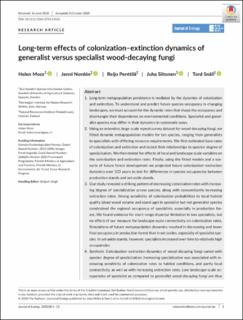Long-term effects of colonization–extinction dynamics of generalist versus specialist wood-decaying fungi
Peer reviewed, Journal article
Published version

Åpne
Permanent lenke
https://hdl.handle.net/11250/2686667Utgivelsesdato
2020Metadata
Vis full innførselSamlinger
- Publikasjoner fra CRIStin - NINA [2364]
- Scientific publications [1392]
Originalversjon
10.1111/1365-2745.13526Sammendrag
1. Long-term metapopulation persistence is mediated by the dynamics of colonization and extinction. To understand and predict future species occupancy in changing landscapes, we must account for the dynamic rates that shape the occupancy and disentangle their dependence on environmental conditions. Specialist and generalist species may differ in their dynamics in systematic ways. 2. Using an extensive, large-scale repeat survey dataset for wood-decaying fungi, we fitted dynamic metapopulation models for ten species, ranging from generalists to specialists with differing resource requirements. We first estimated base rates of colonization and extinction and tested their relationships to species' degree of specialization. We then tested for effects of local and landscape scale variables on the colonization and extinction rates. Finally, using the fitted models and a scenario of future forest development we projected future colonization–extinction dynamics over 100 years to test for differences in species occupancies between production stands and set-aside stands. 3. Our study revealed a striking pattern of decreasing colonization rates with increasing degree of specialization across species, along with concomitantly increasing extinction rates. Strong sensitivity of colonization probabilities to local habitat quality (dead wood volume and stand age) in specialist but not generalist species constrained the regional occupancy of specialists, especially in production forest. We found evidence for short-range dispersal limitation in two specialists, but no effect of our measure for landscape-scale connectivity on colonization rates. Simulations of future metapopulation dynamics resulted in decreasing and lower final occupancy in production forest than in set-asides, especially of specialist species. In set-aside stands, however, specialists increased over time to relatively high occupancies. 4. Synthesis. Colonization–extinction dynamics of wood-decaying fungi varied with species' degree of specialization. Increasing specialization was associated with increasing sensitivity of colonization rates to habitat conditions, and partly local connectivity, as well as with increasing extinction rates. Low landscape-scale occupancies of specialist as compared to generalist wood-decaying fungi are thus maintained by a combination of lower colonization rates, particularly in production forest, and higher extinction rates. colonization–extinction dynamics, decomposer fungi, dynamic occupancy model, ecological specialization, forestry, landscape ecology, land-use scenario, metapopulation
